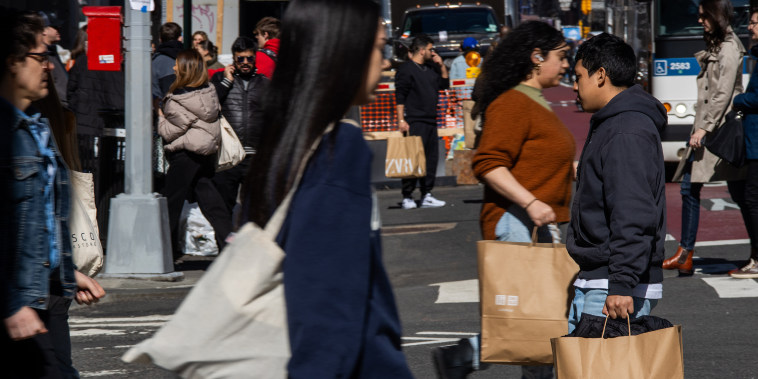Retail’s biggest winners during first-quarter earnings aren’t thriving because consumers are suddenly spending more on discretionary goods — it’s because they’re executing well and cash-strapped shoppers are choosing them over competitors.
If there’s one takeaway from results posted by the largest U.S. retailers over the last few weeks, it’s that shoppers are still spending — but being far more selective about where.
Feeling the brunt of sticky inflation, high interest rates and an economy that feels tougher than it may actually be, consumers are prioritizing purchases that have the right combination of value, convenience and fun.
Companies like Abercrombie & Fitch, TJX Companies and Gap impressed Wall Street with their results, while others like Kohl’s, American Eagle and Target disappointed.
Take Gap and Foot Locker — two unlikely winners that posted results on Thursday. Both retailers are in the midst of ambitious turnaround plans and are performing better than expected because of new strategies they’ve implemented.
Gap posted positive comparable sales for all four of its brands — Athleta, Old Navy, Banana Republic and its namesake banner — for the first time in “many years,” beating Wall Street’s expectations across the board, the company said.
For years, Gap had been losing market share to buzzy competitors. But under new CEO Richard Dickson, the marketing guru credited with reviving the Barbie franchise, the apparel chain has focused on financial rigor, brand storytelling and product development. In under a year, Gap’s sales and profits have meaningfully improved, and its brands are beginning to be part of the cultural conversation again.
A few weeks ago, actor Anne Hathaway went to a Bulgari party wearing a white Gap shirt dress that had been designed by the company’s new creative director, Zac Posen. Critically, Gap dropped the $158 dress to consumers, and it sold out within hours. This combination of marketing and exclusive product drops is what Gap had long been lacking, and what competitors had already been doing.
Foot Locker had declined over the last couple of years, but with the right combination of new strategies and a little bit of luck, its turnaround is showing signs of life.
Under CEO Mary Dillon, Foot Locker has worked to change its stores, where it does more than 80% of its sales. It has tried to create not only a better shopping experience for consumers but also a better place for its critical brand partners.
Instead of two walls of shoes with competing brands mixed together, Foot Locker is changing its fleet so the brands have their own unique displays. Its new “store of the future” concept at a New Jersey mall that brings that strategy to life has become its best performing store in North America in just a few weeks, Dillon told CNBC, adding that brands are thrilled with the new design.
The shift couldn’t have come at a better time. Years into Nike’s strategy to cut out wholesalers and sell directly to consumers, the retailer is realizing it went too far and is now changing course.
With refreshed stores and better product displays, consumers are converting more, too, and paying full price — even Foot Locker’s lower-income shopper.
“Our consumer … this is a category that is very important to them. So when people have discretionary income, it may be limited, but you’re gonna prioritize where you spend it, right?” said Dillon. “We’re proving that people are willing to spend full price, but you have to have the right products and serve it up in a way that makes it enticing, right? So that’s where the whole customer experience really matters.”
Elsewhere, Dick’s Sporting Goods posted a solid first-quarter report Wednesday, as executives said average selling prices and transactions rose and that they saw no signs of consumers trading down for cheaper options. That may not mean shoppers are spending more broadly, though: Dick’s has long been considered a best-in-class operator that offers a solid shopping experience, meaning it can win even when consumers are picky with their spending.
Two retailers that didn’t have great quarters — American Eagle and Kohl’s — tell a story of missing out on trends or executing poorly.
American Eagle handily beat earnings estimates thanks to a new strategy designed to boost profitable growth, but it fell short on revenue and issued cautious guidance that was slightly below Wall Street’s expectations.
American Eagle president and executive creative director Jennifer Foyle told CNBC that the brand is working to cut out items that aren’t landing with shoppers and dig down into the ones that are. She said the retailer was overly focused on jeggings in the past but now, low-rise, baggy fits are in.
During a store visit at the American Dream mall in New Jersey on Thursday, an associate told CNBC that the location didn’t have the low-rise, baggy fit in-stores, and they were only available online. Meanwhile, there was a wall of jeggings. Still, denim was a strong performer for the company during the quarter, and it had a variety of other styles that resonated with customers at the location, the company said.
Denim is having a moment with shoppers. Search levels for denim are hitting peaks in a 20-year data set, particularly for categories like tops and dresses, according to a Morgan Stanley research note.
Kohl’s is missing the mark in a far more meaningful way. The retailer posted dismal numbers on Thursday, as both earnings and revenue fell well short of expectations. It cut its full-year forecast and its shares plunged more than 20%, the stock’s biggest single-day percentage decline ever.
The weak results illustrated a challenge the retailer is still contending with: Keeping up with trends and staying relevant.
CEO Tom Kingsbury told CNBC he expects the “head-to-toe” denim trend to play a role in the back half of the year, but it could already be out of style by the time Kohl’s gets around to adding the clothing items to its shelves.
“Denim is OK business for us. I mean it’s really not the most important time for denim,” said Kingsbury. “We’re selling shorts and tees. And more, you know, warm weather product.”
Gap, one of the longtime denim leaders, didn’t seem to be concerned about denim going out of favor because the weather is warmer. CEO Dickson said the company is getting ready to launch its “exclusive lightweight denim fabric” dubbed “Ultra Soft” in time for the summer.
Failing to chase trends has been an ongoing issue for the aging department store Kohl’s. Kingsbury told CNBC in March that Kohl’s used to buy product for the juniors department catering to teen girls — one of the most trend-driven areas of its stores — 12 to 14 months in advance. When the apparel hit the sales floor, it was “dead on arrival.”
In an age where viral TikTok videos dictate the life and death of trends, it’s more important than ever for retailers to stay on top of what’s working with customers and what isn’t. They’re not just competing with legacy players, they’re also vying for customers with innovative yet controversial upstarts like Chinese-linked Shein, which can go from an idea to an online product in a matter of weeks.
That’s a far cry from the lead times at Under Armour, where it currently takes about 18 months to get a product from an idea to a showroom floor. During an earnings call with analysts on May 16, CEO Kevin Plank called the system “just plain uncompetitive in the 2024 landscape” as he laid out a plan to streamline the process.
Meanwhile, Abercrombie & Fitch posted another stellar set of results, even as it begins to lap tougher comparisons. It has posted torrid growth in part because the company is responsive to its customers and a has nimble supply chain that has allowed it to chase trends quickly and efficiently.
It posted its strongest first quarter in history, and now expects sales to grow 10% in fiscal 2024, up from previous guidance of between 4% and 6%.
CEO Fran Horowitz told CNBC that low-rise, baggy jeans are also uber-popular with its customers. During a recent visit by CNBC to its Hollister store just a short walk from American Eagle’s outpost, plenty of those style of jeans were on display for shoppers as soon as they walked into the store.

